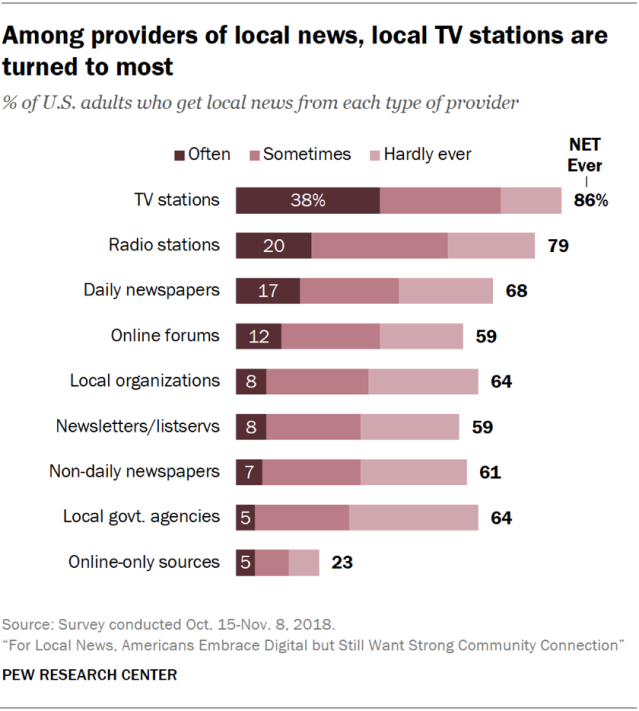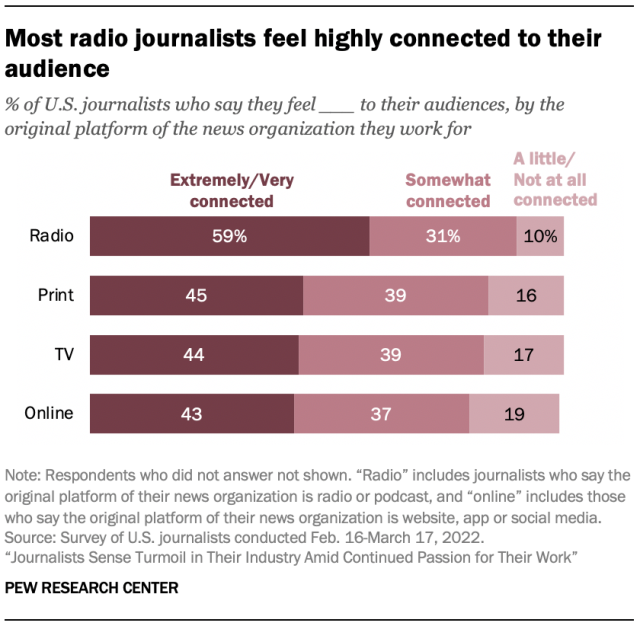
National Radio Day, celebrated on Aug. 20 in the United States, acknowledges the invention of the radio as an essential form of mass media communication. To mark the occasion, here are seven facts from Pew Research Center analyses about the state of radio in the U.S.
For National Radio Day, Pew Research Center conducted this analysis to provide findings about radio listeners, radio journalists and the broader radio industry in the United States. All findings are based on previously published studies by the Center. Details about the methodology of each study, including survey sample sizes and field dates, are available by following the links in this analysis.
Pew Research Center is a subsidiary of The Pew Charitable Trusts, its primary funder. This is the latest analysis in Pew Research Center’s ongoing investigation of the state of news, information and journalism in the digital age, a research program funded by The Pew Charitable Trusts, with generous support from the John S. and James L. Knight Foundation.
About eight-in-ten Americans ages 12 and older listen to terrestrial radio in a given week. Weekly terrestrial radio listenership in the U.S. has remained relatively stable in the last two years after dipping slightly in 2020. In 2022, 82% of Americans ages 12 and older listened to terrestrial radio in a given week, according to Nielsen Media Research data published by the Radio Advertising Bureau. Weekly listenership dropped from 89% in 2019 to 83% in 2020, a decline that coincided with the beginning of the U.S. coronavirus outbreak.
Weekly terrestrial radio listenership
% of Americans ages 12 and older who listen to terrestrial (AM/FM) radio in a given week
| Year | Listen to terrestrial radio |
|---|---|
| 2009 | 92% |
| 2010 | 92% |
| 2011 | 93% |
| 2012 | 92% |
| 2013 | 92% |
| 2014 | 91% |
| 2015 | 91% |
| 2016 | 91% |
| 2017 | 90% |
| 2018 | 89% |
| 2019 | 89% |
| 2020 | 83% |
| 2021 | 84% |
| 2022 | 82% |
Source: Nielsen Audio RADAR 156, March 2023, publicly available via Radio Advertising Bureau.
PEW RESEARCH CENTER
Nearly half of U.S. adults say they sometimes or often get news from radio. In a summer 2022 Pew Research Center survey, 47% of U.S. adults said they get news from radio at least sometimes, a figure that has remained relatively constant in recent years. In the same survey, just 7% of U.S. adults said they prefer radio to other platforms for getting news.

White and Black Americans are equally likely to get news at least sometimes from radio (48% each). Meanwhile, 42% of Hispanic adults and 37% of Asian adults say they get news from radio at least sometimes.
When it comes to age, adults 50 to 64 are the most likely to get news at least sometimes from radio, with just over half (55%) saying they do this; 48% of those ages 30 to 49, 46% of those 65 and older, and 35% of those 18 to 29 say the same.
One-in-five U.S. adults say they often get local news from radio stations, according to a 2018 Center survey. That was below the share of U.S. adults who say they often get local news from TV stations (38%) but comparable to the share who often get local news from daily newspapers (17%). It was higher than the shares who get local news from online forums (12%) or other types of outlets.

Audiences for public radio, including National Public Radio (NPR) and Public Radio Exchange (PRX), have declined in recent years. In 2022, the top 20 NPR-affiliated public radio stations by listenership had an average weekly audience of about 8 million, down 10% from 2021. Looking at NPR programming across all stations that carry it, weekly terrestrial broadcast listenership declined by 6% between 2021 and 2022. And the terrestrial audience for PRX declined to about 6.7 million average weekly listeners, a 24% drop from 2021.
NPR weekly broadcast audience
Average weekly terrestrial listenership
| Year | Listenership |
|---|---|
| 2005 | 25300000 |
| 2006 | 25,500,000 |
| 2007 | 25,500,000 |
| 2008 | 26,400,000 |
| 2009 | 26,400,000 |
| 2010 | 27,200,000 |
| 2011 | 26,800,000 |
| 2012 | 26,000,000 |
| 2013 | 27,300,000 |
| 2014 | 26,200,000 |
| 2015 | 26,000,000 |
| 2016 | 29,700,000 |
| 2017 | 30,100,000 |
| 2018 | 28,500,000 |
| 2019 | 28,000,000 |
| 2020 | 26,100,000 |
| 2021 | 25,100,000 |
| 2022 | 23,500,000 |
Source: NPR, based on data from Nielsen Audio Nationwide, for persons 12+.nn
PEW RESEARCH CENTER
PRX weekly broadcast audience
Average weekly terrestrial listenership
| Year | Listenership |
|---|---|
| 2015 | 8,132,000 |
| 2016 | 8,861,000 |
| 2017 | 8,813,000 |
| 2018 | 9,666,300 |
| 2019 | 9,583,900 |
| 2020 | 9,476,600 |
| 2021 | 8,884,700 |
| 2022 | 6,719,000 |
Note: Data for 2015-2018 is for PRI only.
Source: PRX, based on data from fall 2022 Nielsen Audio Nationwide.
PEW RESEARCH CENTER
Average revenue at news-focused radio stations in the U.S. remains lower than before the coronavirus pandemic, according to a Pew Research Center analysis of data from BIA Advisory Services’ MEDIA Access Pro. Average revenue for stations in the all-news format was $17.8 million in 2022 – up from $15.9 million in 2020 but well below the $21 million recorded in 2019, before the pandemic. (The BIA Advisory Services database contains revenue data during these years for only 15 of the 27 all-news stations. Therefore, only those stations are included in these averages.)
Average station revenue by programming category
Average station revenue for all-news radio stations (in U.S. dollars)
| Year | Average station revenue |
|---|---|
| 2015 | $22,625,000 |
| 2016 | $22,670,000 |
| 2017 | $21,422,000 |
| 2018 | $21,115,000 |
| 2019 | $20,990,000 |
| 2020 | $15,863,000 |
| 2021 | $17,865,000 |
| 2022 | $17,773,000 |
Note: Data from previous years is updated annually. The BIA Advisory Services database contains revenue data for every year shown in the chart for 15 of the 27 all-news stations; therefore, only those stations are included in the averages. BIA Advisory Services does not typically report revenue for stations that are not part of a radio market. Data includes full-power AM and FM radio stations in the BIA Advisory Services database in 50 U.S. states and the District of Columbia.
Source: Pew Research Center analysis of MEDIA Access Pro & BIA Advisory Services data.
PEW RESEARCH CENTER
Most radio journalists feel highly connected to their audience. In the Center’s 2022 survey of journalists in the U.S., about six-in-ten radio and podcast journalists (59%) said they felt extremely or very connected to their listeners. That was significantly higher than the 45% of print journalists, 44% of TV journalists and 43% of online journalists who said the same.

The share of Americans who listen to podcasts has increased substantially over the last decade. As of 2023, 42% of Americans ages 12 and older have listened to a podcast in the past month, according to “The Infinite Dial” report by Edison Research. This has remained relatively constant since 2020, when 37% had listened to a podcast in the past month. A decade ago, in 2013, just 12% of Americans 12 and older said they had listened to a podcast in the past month.
Title
Subtitle
| Year | Ever | In the past month | In the past week |
|---|---|---|---|
| 2006 | 11% | ||
| 2007 | 13% | ||
| 2008 | 18% | 9% | |
| 2009 | 22% | 11% | |
| 2010 | 23% | 12% | |
| 2011 | 25% | 12% | |
| 2012 | 29% | 14% | |
| 2013 | 27% | 12% | 7% |
| 2014 | 30% | 15% | 8% |
| 2015 | 33% | 17% | 10% |
| 2016 | 36% | 21% | 13% |
| 2017 | 40% | 24% | 15% |
| 2018 | 44% | 26% | 17% |
| 2019 | 51% | 32% | 22% |
| 2020 | 55% | 37% | 24% |
| 2021 | 57% | 41% | 28% |
| 2022 | 62% | 38% | 26% |
| 2023 | 64% | 42% | 31% |
Note: This is a note.
Source: This is your source.
PEW RESEARCH CENTER
Roughly half of Americans (51%) say they have listened to a podcast in the past year, including one-in-five who report listening to podcasts at least a few times a week, according to a 2022 Center survey. Among U.S. podcast listeners, two-thirds say news is discussed on the podcasts they listen to.
Unlike with radio, younger adults are more likely than older adults to listen to podcasts. Two-thirds (67%) of Americans ages 18 to 29 have listened to a podcast in the past 12 months, compared with just 28% of those 65 and older.
Note: This is an update of a post originally published Feb. 13, 2023.
Intern Alexis Moulton contributed to this fact sheet.
